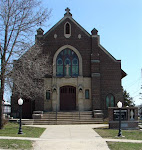Wednesday, June 10, 2009
Custom of Standing When a Priest Walks in the Room
Father,
I remember in the not so distant past when it was the norm for everyone to stand when a priest entered a room or gathering. I understood that this action was to recognize the priest, "in persona Christi," but I seldom - if ever - see it in practice anymore, which seems a great shame. Can you tell me if the practice was discouraged after Vatican II or perhaps Catholics have lost the understanding of "in persona Christi?"
Julia
Julia,
I grew up after the council and was never familiar with this practice. However, I assume that it was just that, a practice or custom. I would think that the custom of standing when a priest enters the room probably has two aspects of significance. One would be the great respect given priests in the life of the Church. While this respect exists today it is reduced in today's Catholic culture (what remains of it anyway). The second significance of this practice is most likely reflective of the greater level of formality and respect for authority once present in society as a whole which has also diminished in recent decades. As for how many Catholics understand the identity of the priest as "in personae Christi" I'm not sure how many understood it back in the day and I'm quite certain most do not today. While the reality of the priest as "in personae Christi" is a good theological reason for the respect shown the priest I suspect that for most the practice of standing was simply a form of respect. While some persons no doubt may have consciously discouraged this practice I suspect that this custom declined as part of the great cultural phenomenon of less formality, less overt respect for authority and the significant loss of the cultural patrimony of the Church that happened in the wake of the council. Should you resume this practice as a healthy respect for the authority and the identity of the priest? I don't see any problem with that. However, you might need to point out and explain to others why you are doing it. In addition, some may consider it as a lack of humility on the part of the priest to accept such gestures. I would point out that just as a priest should humbly fulfill his servant role as a priest so should a priest humbly receive such honor given him not for his own glory but rather for his role as a priest and for the importance that this holds for the faithful in the life of the Church.
Fr. Pisut
Custom of Standing When a Priest Walks in the RoomI remember in the not so distant past when it was the norm for everyone to stand when a priest entered a room or gathering. I understood that this action was to recognize the priest, "in persona Christi," but I seldom - if ever - see it in practice anymore, which seems a great shame. Can you tell me if the practice was discouraged after Vatican II or perhaps Catholics have lost the understanding of "in persona Christi?"
Julia
Julia,
I grew up after the council and was never familiar with this practice. However, I assume that it was just that, a practice or custom. I would think that the custom of standing when a priest enters the room probably has two aspects of significance. One would be the great respect given priests in the life of the Church. While this respect exists today it is reduced in today's Catholic culture (what remains of it anyway). The second significance of this practice is most likely reflective of the greater level of formality and respect for authority once present in society as a whole which has also diminished in recent decades. As for how many Catholics understand the identity of the priest as "in personae Christi" I'm not sure how many understood it back in the day and I'm quite certain most do not today. While the reality of the priest as "in personae Christi" is a good theological reason for the respect shown the priest I suspect that for most the practice of standing was simply a form of respect. While some persons no doubt may have consciously discouraged this practice I suspect that this custom declined as part of the great cultural phenomenon of less formality, less overt respect for authority and the significant loss of the cultural patrimony of the Church that happened in the wake of the council. Should you resume this practice as a healthy respect for the authority and the identity of the priest? I don't see any problem with that. However, you might need to point out and explain to others why you are doing it. In addition, some may consider it as a lack of humility on the part of the priest to accept such gestures. I would point out that just as a priest should humbly fulfill his servant role as a priest so should a priest humbly receive such honor given him not for his own glory but rather for his role as a priest and for the importance that this holds for the faithful in the life of the Church.
Fr. Pisut




